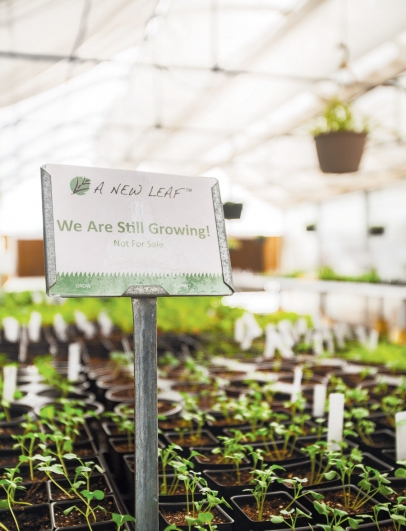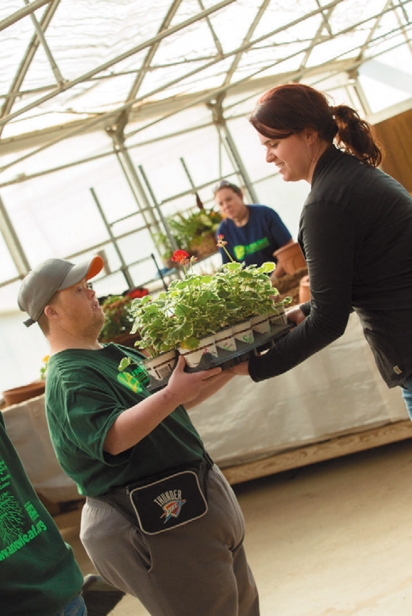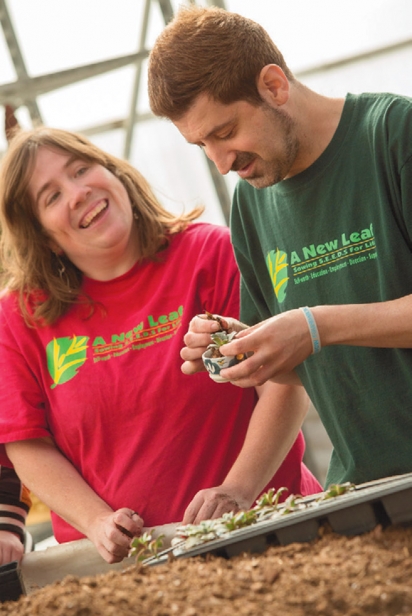Blooming Hearts and Minds
Last year, Michelle Hood had a realization. Bent over a row of vegetable crops under the hot sun, her hands deep in dirt, she popped up suddenly.
“I’m a farmer!” she exclaimed, delighted.
It was as though she had literally turned over a new leaf out there in the fields and, beneath it, discovered something about herself: a competency and capability she hadn’t expected to find.
These simple revelations drive the mission of A New Leaf, a Tulsabased nonprofit that serves people with developmental disabilities. For such individuals, life’s path does not always line up neatly with the traditional school-career trajectory. According to A New Leaf, “Less than 15% of all developmentally disabled individuals are active in the community through employment.”
Forty years ago, parents did not have many options for nurturing independence in children with disabilities. Keeping them at home and sheltering them from social shunning was often the best parents felt they could do. In 1979, Stan and Irene Burnstein were looking for a better way of life for their daughter. With the proper support, they believed she could thrive and contribute to her community despite her disabilities. A search across the country for programs to use as a model led the Burnsteins to start A New Leaf, a horticultural-related job training program.
At first, A New Leaf consisted of one greenhouse, one job coach and two individuals with developmental disabilities. Today, six greenhouses serve the vocational program with two retail locations, a wholesale route, additional programming in public schools and a residential program. There are currently 325 individuals being served by A New Leaf. Vocational participants are paid an hourly wage for work that aligns with their abilities. The goal is to promote and enhance independence at the highest level for each individual, whether it’s preparing a meal for oneself or developing marketable job skills and living on one’s own.
Farming was not originally part of A New Leaf’s programming. Greenhouse-grown flowers were more their speed. But late in 2014, the organization was awarded an Innovation Grant from the Tulsa Area United Way and they set out to simultaneously tackle two systemic issues facing the Tulsa area: job creation for individuals with disabilities and the lack of fresh produce for low-income families.
Kayla Jones, director of marketing and business development for A New Leaf, describes Blooming Acres, a community-supported agriculture program, as a natural progression. Searching for new ways to serve both their clients and the larger community, the administration needed to look no further than their own backyard. The Broken Arrow property, with three acres sitting vacant, inspired a visionary administration to declare: “We’re the plant people! We have to do something back there.”
Jones, who joined A New Leaf from Procter & Gamble in New York City, had no background in horticulture when she joined the organization a little over a year ago. Nevertheless, she embraced the Blooming Acres project, getting the raised beds started before hiring Nicole Pittman as the horticulture manager.
A high tunnel and 25 raised beds later, Blooming Acres grew over 2,000 pounds of produce in 2016. The public is invited to participate through a community-supported agriculture (CSA) harvest subscription program. Seasonal shares range from $95 to $270, and include delivery within the Tulsa region or pickup options in Tulsa and Broken Arrow. Spring shareholders might find beets, broccoli, radishes carrots, mixed greens, spinach and fresh herbs in their weekly delivery.
“A lot of people don’t know what to do with radishes or beets,” Pittman says, so deliveries are always accompanied by recipes to support healthy eating.
An unanticipated benefit of the Blooming Acres project has been the health benefit to A New Leaf clients, who are not always in top physical shape. Gardening, a physically demanding outdoor activity, gets clients moving. They are also learning to appreciate a vegetable-rich diet.
“A lot of these clients are more willing to try something that they grew, so it’s encouraging great eating habits as well,” says Maranda Figueroa, director of development for A New Leaf.
***
When we visit A New Leaf early in the year the spring babies—Swiss chard, onions, peas and herbs—are just starting to germinate. Seeding and transplanting have taken place in the greenhouse-classroom, where clients are divided up according to their skill sets. Step-by-step visual instructions lead clients through their tasks. Jonathan Boyd, 23, a black-and-white thinker, excels at seeding. His attention to detail pays off in the early stages of farming, before things get messy in the fields.
“My favorite part is, I like to go on deliveries and ride around,” he says. Deliveries seem to be everyone’s favorite part of the work.
Out of the 2,000 pounds of produce grown in 2016, A New Leaf gave away half. Some was donated to their own clients but most went to local food banks and nonprofits serving low-income families.
Inspired by these deliveries to those in need, newly minted farmer Michelle Hood took it upon herself to raid her own pantry, personally subsidizing the donation to food banks.
“They’ve learned so much,” Pittman says of the clients she works with, “and it’s amazing to watch them go from seed to produce and have something they can give back to the community.”
In the future, A New Leaf plans to weave together the residential and horticulture programs. A capital campaign is in the works that would enable the organization to develop a farm-centered housing facility for clients called an “agrihood.”
What started as an innovative idea to expand programming has bloomed into a thriving, fullscale agriculture project. Going forward, A New Leaf plans to make farming and sustainable food production a part of roots.
For more information about the Blooming Acres CSA, go to:
ANewLeaf.org/blooming-acres-csa-registration/











